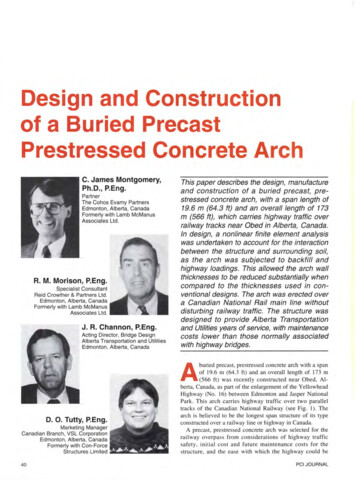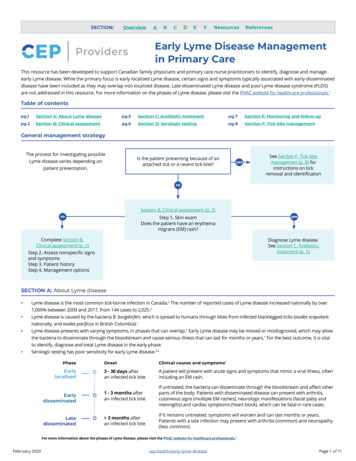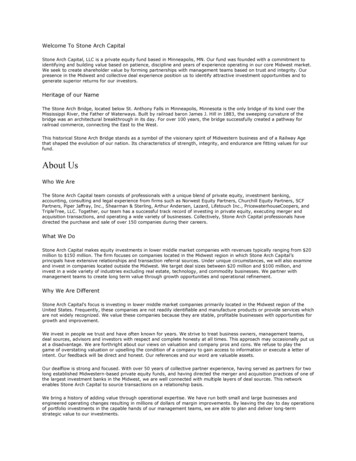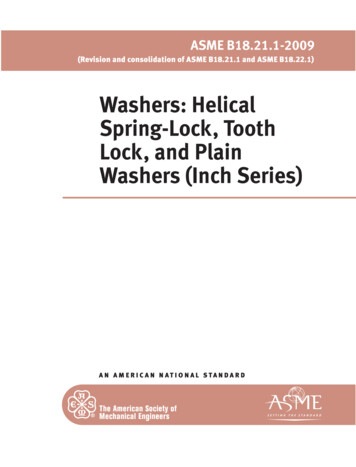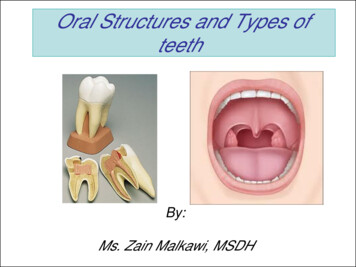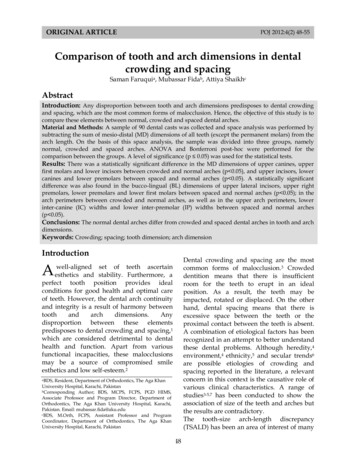
Transcription
ORIGINAL ARTICLEPOJ 2012:4(2) 48-55Comparison of tooth and arch dimensions in dentalcrowding and spacingSaman Faruquia, Mubassar Fidab, Attiya ShaikhcAbstractIntroduction: Any disproportion between tooth and arch dimensions predisposes to dental crowdingand spacing, which are the most common forms of malocclusion. Hence, the objective of this study is tocompare these elements between normal, crowded and spaced dental arches.Material and Methods: A sample of 90 dental casts was collected and space analysis was performed bysubtracting the sum of mesio-distal (MD) dimensions of all teeth (except the permanent molars) from thearch length. On the basis of this space analysis, the sample was divided into three groups, namelynormal, crowded and spaced arches. ANOVA and Bonferroni post-hoc were performed for thecomparison between the groups. A level of significance (p 0.05) was used for the statistical tests.Results: There was a statistically significant difference in the MD dimensions of upper canines, upperfirst molars and lower incisors between crowded and normal arches (p 0.05), and upper incisors, lowercanines and lower premolars between spaced and normal arches (p 0.05). A statistically significantdifference was also found in the bucco-lingual (BL) dimensions of upper lateral incisors, upper rightpremolars, lower premolars and lower first molars between spaced and normal arches (p 0.05); in thearch perimeters between crowded and normal arches, as well as in the upper arch perimeters, lowerinter-canine (IC) widths and lower inter-premolar (IP) widths between spaced and normal arches(p 0.05).Conclusions: The normal dental arches differ from crowded and spaced dental arches in tooth and archdimensions.Keywords: Crowding; spacing; tooth dimension; arch dimensionIntroductionDental crowding and spacing are the mostcommon forms of malocclusion.3 Crowdeddentition means that there is insufficientroom for the teeth to erupt in an idealposition. As a result, the teeth may beimpacted, rotated or displaced. On the otherhand, dental spacing means that there isexcessive space between the teeth or theproximal contact between the teeth is absent.A combination of etiological factors has beenrecognized in an attempt to better understandthese dental problems. Although heredity,4environment,4 ethnicity,5 and secular trends6are possible etiologies of crowding andspacing reported in the literature, a relevantconcern in this context is the causative role ofvarious clinical characteristics. A range ofstudies3-5,7 has been conducted to show theassociation of size of the teeth and arches butthe results are contradictory.The tooth-size arch-length discrepancy(TSALD) has been an area of interest of manyAwell-aligned set of teeth ascertainesthetics and stability. Furthermore, aperfect tooth position provides idealconditions for good health and optimal careof teeth. However, the dental arch continuityand integrity is a result of harmony betweentoothandarchdimensions.Anydisproportion between these elementspredisposes to dental crowding and spacing,1which are considered detrimental to dentalhealth and function. Apart from variousfunctional incapacities, these malocclusionsmay be a source of compromised smileesthetics and low self-esteem.2aBDS,Resident, Department of Orthodontics, The Aga KhanUniversity Hospital, Karachi, PakistanbCorresponding Author; BDS, MCPS, FCPS, PGD HIMS,Associate Professor and Program Director, Department ofOrthodontics, The Aga Khan University Hospital, Karachi,Pakistan. Email: mubassar.fida@aku.educBDS, M.Orth, FCPS, Assistant Professor and ProgramCoordinator, Department of Orthodontics, The Aga KhanUniversity Hospital, Karachi, Pakistan48
POJ 2012:4(2) 48-55Material and Methodsresearchers and several factors such as toothdimensions, arch widths and lengths havebeen found to be related to this discrepancy.Initially, Siepel8 showed that the positions ofteeth in the dental arch can be determined byconsidering the size of the teeth and theamount of space available for them in thedental arch. This was followed by a study byLundström9 reporting two factors accountablefor dental crowding i.e. the increase in mesiodistal (MD) dimensions of teeth and thedecrease in dental arch dimensions.The biometric study by Puri et al3 confirmedthat crowded arches consistently had largerteeth than the normal arches. They alsoshowed that smaller teeth, particularly thesmall mandibular incisors are responsible fordental spacing. In addition to the MDdimensions of teeth, the bucco-lingual (BL)dimensions have also been found to affect thedental alignment. In a recent study, thepermanent crown dimensions in young menwith naturally good occlusions werecompared with those who requiredorthodontic treatment.10 The results showedthat tooth crown dimensions (MD as well asBL) were significantly larger in subjects withmalocclusions than in those with goodocclusions. In contrast, Bernabe and FloresMir11 showed that crowded and normalarches differ significantly in their MD toothsizes and arch length but not in their BL toothsizes. Loren12 found a significant associationbetween malalignment of teeth and archwidth, however he concluded that arch lengthand incisor crown diameter do not vary inindividuals with and without malalignment.Dental crowding and spacing are theconsequences of TSALD which is a significantarea to investigate because it has an influenceon treatment methods and retention. Hence,the present study was planned with theobjective of comparing the tooth and archsizes between normal, crowded and spaceddental arches.This cross-sectional study was conducted attheorthodonticclinic.Priortocommencement of treatment, informedconsent was obtained from patients and/orparents that their records might be used forresearch purpose. A sample of 90 dental castsof Pakistani subjects aged above 11 years wascollected. The dental casts were selected fromthe records of the patients seekingorthodontic treatment which met theinclusion criteria: (1) pretreatment casts ofsubjects with no prior history of orthodontictreatment, (2) well erupted permanentdentition permitting proper measurements ofcrown dimensions, and (3) good qualityorthodontic casts. Casts with any toothdevelopmentaldisorder,missing,supernumerary or carious teeth, worn outdentition, or large coronal restorations werenot included in this study.The TSALD was calculated in each arch as thenumerical difference between the sum of MDtooth dimensions and the arch perimetermesial to the first permanent molars. Thegrouping of sample was done on the basisthis space discrepancy. In this study, archeswith a space discrepancy of 0 3 mm weredefined as normal, arches with a spacediscrepancy of more than - 4 mm weredefined as crowded and arches with a spacediscrepancy of more than 4 mm werelabeled as spaced arches.A total of 90 casts met the criteria of groupingand they were divided into normal, crowded,and spaced dental arches groups with 30 castsin each group. Each group was furtherdivided into 15 maxillary and 15 mandibularcasts.For each cast, the following parameters wererecorded: the MD and BL crown diameters ofall teeth except the second and thirdpermanent molars; the inter-canine (IC), interpremolar (IP) and inter-molar (IM) widths;the arch perimeter; and the arch depth. TheMD crown width was measured as thegreatest distance between the contact points49
POJ 2012:4(2) 48-55of the approximal surfaces of the dentalcrown, with the calipers parallel to theocclusal and buccal surfaces (Fig 1).1 The BLcrown diameter was measured as the greatestdistance between the facial and lingualsurfaces of the crown, taken at right angles tothe plane in which the mesiodistal diameter istaken (Fig 2).13 IC width was measured as thehorizontal distance between the cusp tips ofthe canines (Fig 3),14 IP width as thehorizontal distance between the distal pit ofthe maxillary first premolar (Fig 3) or thedistal fossae of the mandibular firstpremolar,14 and IM width as the horizontaldistance between the central fossae of themaxillary first molars (Fig 3) or the distobuccal cusp tips of the mandibular firstmolars.14Arch depth was taken as theperpendicular distance between the incisoredges of central incisors and a line connectingthe mesial surfaces of the first molars on bothsides (Fig 3).15Figure 2: Measurement of bucco-lingual (BL)dimension of teethFigure 3: Measurement of arch dimensions:a, inter-canine (IC) width; b, maxillary interpremolar (IP) width; c, maxillary inter-molar(IM) width; d, arch depthUp to 5 pairs of dental casts were examinedeach day to evade eye exhaustion. One weekafter the data collection, 10 dental casts wererandomlyselectedandreplicatedmeasurements were made by the sameinvestigator to detect any measurement error,however, Pearson correlation did not showany statistically significant difference for theintra-examiner reliability (r 0.93, p 0.01).All data were analyzed with SPSS software(version 19.0, SPSS Inc., Chicago). Descriptivemeasures such as means, standard deviations,and standard errors of the mean werecalculated for each variable. Oneway analysisFigure 1: Measurement of mesio-distal (MD)dimension of teethAll the measurements were made by oneexaminer using a digital vernier caliper (0-150mmME00183,Dentaurm,Pforzheim,Germany) with accuracy of 0.02 mm andreliability of 0.01 mm manufacturer’sspecification.50
POJ 2012:4(2) 48-55of variance (ANOVA) was used to comparethe three groups and Post Hoc Bonferroni testwas applied to assess group differences in thecrown and arch dimensions. A level ofsignificance (p 0.05) was used for thestatistical tests.except first permanent molars betweencrowded and spaced arches.The comparison of BL dimensions of teethbetween normal, crowded, and spaced dentalarches showed that maxillary lateral incisorsand all premolars and first molars weresignificantly different in the three groups(Table III). When Post Hoc Bonferroni testwas applied to further assess the inter-groupvariations (Table IV), no significant differencewas noticed in the BL dimensions of teethbetween normal and crowded arches.Whereas, a statistically significant differencewas found in the BL dimensions of maxillarylateral incisors and right premolars, andmandibular premolars and first molarsbetween normal and spaced dental arches.A statistically significant difference wasdetermined in all the arch dimensionsbetween normal, crowded, and spaced dentalarches with the exception of mandibular archdepth (Table V). Table VI shows theintergroupcomparisonconfirmingastatistically significant difference in the archperimeter of maxillary and mandibular archesbetween normal and crowded arches. Whennormal and spaced arches were compared, asignificant difference was observed in thearch perimeter of maxillary arches, and ICand IP widths of mandibular arches.ResultsThe comparison of MD dimensions of teethbetween normal, crowded, and spaced dentalarches by ANOVA showed that all teethexcept mandibular first permanent molarswere significantly different in the threegroups (Table I). Table II illustrates the groupdifferences in the MD tooth dimension usingPost Hoc Bonferroni test. When the maxillarycasts were compared, a statistically significantdifference was found in the MD dimensionsof canines and first permanent molarsbetween normal and crowded arches, in theMD dimensions of all incisors betweennormal and spaced arches, and in the MDdimensions of all teeth between crowded andspaced arches. When mandibular casts werecompared, there was a statistically significantdifference in the MD dimensions of allincisors between normal and crowded arches,in the MD dimensions of canines andpremolars between normal and spacedarches, and in MD dimensions of all teethTable I: Comparison of MD dimensions of teeth in three groupsToothDental Arch(N 90)Maxilla(n 45)Mandible(n 010.0010.0020.0010.0010.069N 90One-way ANOVAp-value 0.0551
POJ 2012:4(2) 48-55Table II: Comparison of MD dimensions of teeth between the three groupsToothDental Arch(N 20.0010.064N normal arch, C crowded arch, S spaced archN 90Post Hoc Bonferronip-value 0.05Table III: Comparison of BL dimensions of teeth in the three groupsToothDental Arch(N 90)Maxilla(n 45)Mandible(n .2720.1700.3250.0020.0010.001N 90One-way ANOVAp-value 0.05Table IV: Comparison of BL dimensions of teeth between the three groupsToothDental Arch(N 080.0010.001N normal arch, C crowded arch, S spaced archN 90Post Hoc Bonferronip-value 0.0552
POJ 2012:4(2) 48-55Table V: Comparison of arch dimensions in the three groupsDental Arch(N 90)Normal(Mean)Maxilla(n 45)Crowded(Mean)Spaced(Mean)p-valueMandible(n idthIPWidth33.17135.27533.938Arch N 90One-way ANOVAp-value 0.05Table VI: Comparison of arch dimensions between the three groupsDental Arch(N 8190.1530.0100.4400.0160.001*Arch 0.0030.1140.001*1.0001.0001.000N normal arch, C crowded arch, S spaced archN 90Post Hoc Bonferronip-value 0.05*p-value 0.001Discussionparameters have profound implications inorthodonticdiagnosisandtreatmentplanning. In this study, we aimed todetermine the differences in normal, crowdedand spaced dental arches in terms of toothand arch dimensions to better understand themorphological relationships of these variableswith dental crowding and spacing.The MD tooth sizes in crowded arches werelarger than in normal, although statisticallysignificant differences were found only formaxillary first molars and canines, and formandibular incisors. This was in concordancewith Puriet3 who found that the MDdimensions of individual teeth, the sum of theIt is well established that several etiologicalfactors are associated individually or ingroups to dental crowding and spacing in thepermanent dentition. However, mesiodistaltooth width is considered a primordialcausative factor in space anomalies.16-18Traditionally, orthodontic diagnosis has beenlimited to the determination of the amount ofdental arch space deficiency considering onlythe MD tooth dimension and arch perimeter.19Recent research13,20,21 suggests that othermorphological characteristics such as toothshape and arch dimensions play an importantrole in space discrepancies and these53
POJ 2012:4(2) 48-55incisors and the sum of the canines and thepremolars were uniformly larger in crowdedarches compared with normal dental arches.Our study results were also in agreementwith Peck and Peck22,23and Norderval et al4who found a positive correlation between MDwidth of mandibular incisors and mandibulararch crowding.In contrast, some researchersdo not agree with the idea and show no suchcorrelation.12,25,26The MD tooth dimensions in spaced archeswere smaller than those in normal arches butstatistically significant differences were foundonly for maxillary incisors, and mandibularcanines and premolars. Previous reports haveshown similar results.22,23 In contrast, Puri etal3 found statistically significant differencesfor maxillary premolars and mandibularincisors.Peck and Peck19,22,23 reported that thecrowded arches not only had larger MD toothsize but also shorter BL tooth size, but theirfindings could not be supported in otherstudies. In our study, we observed nostatistically significant difference in the BLtooth dimensions between normal andcrowded arches. However, the BL toothdimensions of maxillary lateral incisors andright premolars and mandibular premolarsand first molars in spaced arches were foundto be significantly smaller than in normalarches.In relation to arch dimensions, statisticallysignificant differences were found in all thevariables between the normal, crowded andspaced dental arches. The only variable withinsignificant difference was mandibular archdepth. This was in conflict to Bernabéet al21who found differences only for IM width andarch perimeter.Previous studies21,25 verified that arches withcrowding were shorter than those withoutcrowding; this was corroborated in our studywhere we observed that the arch perimeter ofcrowded arches were shorter and spacedarches were longer than the arch perimeter ofnormal arches and these differences werefound to be statistically significant. However,no statistically significant difference wasobserved in the mandibular arch perimeterbetween spaced and normal arches. IC widthwas determined to be the arch dimensionwith more contradictory results. Someauthors25,27 have reported differences in ICwidth between crowded and uncrowdeddentitions, whereas others24,33 found nodifferences. In our study, we found that theIC width of spaced arches were significantlylarger than those of the normal arches. Interms of IP width, spaced mandibular archeswere found to be wider than the normalmandibular arches.Conclusions The MD dimensions of all teeth aregreater in crowded arches and smaller inspaced arches as compared to the teeth innormal dental arches.There is no difference in BL dimensions ofteeth between crowded and normal dentalarches; however, the BL dimensions ofsome teeth in spaced dental arches aresmaller than in normal arches.The crowded arches are shorter than thenormal dental arches, whereas spacedmandibular arches are longer than thenormal mandibular arches. No significantdifference is observed between the spacedand normal maxillary arches.The crowded arches and spaced maxillaryarches do not differ from normal archeswhen arch widths are considered.However, spaced mandibular arches arewider than the normal mandibular arches.Hence, we concluded that differences in thetooth and arch dimensions are associatedwith dental-arch discrepancies. The size andshape of the teeth and dental arches will havesubstantial implications in orthodonticdiagnosis and treatment planning, affectingthe space available, dental aesthetics, andstability of the dentition. These factors shouldbe considered while planning an orthodontic54
POJ 2012:4(2) 48-55treatment to determine the requirements forinter-dental stripping, crown recontouring,prosthetic reconstruction or extraction, and toavoid compromising the final results.13. Agenter MK, Harris EF, Blair RN. Influence of op 2009;136:795-804.14. Dalidjan M, Sampson W, and Townsend G.Prediction of dental arch development: Anassessment of Pont's Index in three humanpopulations. Am J OrthodDentofacOrthop 1995;107:465-75.15. Lindsten R, O gaard B, Larsson E, Bjerklin K.Transverse dental and dental arch depthdimensions in the mixed dentition in a skeletalsample from the 14th to the 19th century andnorwegian children and norwegiansami children oftoday. Angle Orthod2002;72:439–448.16. Lundström A. Intermaxillary tooth width ratio andtooth alignment and occlusion. ActaOdontol Scand.1955;12:265–292.17. Bolton WA. Disharmony in tooth size and itsrelation to the analysis and treatment ofmalocclusion. Angle Orthod. 1958;28:113–130.18. Bolton WA. The clinical application of tooth-sizeanalysis. Am J Orthod. 1962;48:504–529.19. Peck S, Peck H. Orthodontic aspects of dentalanthropology. Angle Orthod 1975;43:95-102.20. Shah AA, Elcock C, Brook AH. Incisor crown shapeand crowding. Am J OrthodDentofacialOrthop2003;123:562-7.21. Bernabé E, del Castillo CE, Flores-Mir C. Intra-archocclusal indicators of crowding in the 128:220-5.22. Peck S, Peck H. Crown dimensions and mandibularincisor alignment. Angle Orthod 1972;42:148-53.23. Peck H, Peck S. An index for assessing tooth shapedeviations as applied to the mandibular incisors.Am J Orthod 1972;61:384-401.24. Norderval K, Wisth PJ, Boe OE. Mandibularanterior crowding in relation to tooth size andcraniofacial morphology. Scand J Dent Res1975;83:263-73.25. Howe RP, McNamara JA, O’Connor KA. Anexamination of dental crowding and its relationshipto tooth size and arch dimension. Am J Orthod1983;83:363-73.26. Radnzic D. Dental crowding and its relationship tomesiodistal crown diameters and arch dimensions.Am J OrthodDentofacialOrthop 1988;94:50-6.27. Fastlicht J. Crowding of mandibular incisors. Am JOrthod 1970;58:156-63.28. Melo L, Ono Y, Takagi Y. Indicators of mandibulardental crowding in the mixed dentition. PediatrDent 2001;23:118-22.References1.Moorrees CFA, Reed RB. Correlation among crowndiameters of human teeth. Arch Oral Biol1964;9:685-97.2. Jung M. Evaluation of the effects of malocclusionand orthodontic treatment on self-esteem in anadolescentpopulation.AmJOrthodDentofacialOrthop 2010;138:160-6.3. Puri N, Pradhan L, Chandna A, Sehgal V, Gipta R.Biometric study of tooth size in normal, crowded,and spaced permanent dentitions. Am JOrthodDentofacialOrthop2007;132:279.e7279.e14.4. Normando D, Almeida MA, Quintão CC. Dentalcrowding: the role of genetics and tooth wear.Angle Orthod. 2013;83:10-15.5. Merz ML, Isaacson RJ, Germane N, Rubenstein KL.Tooth diameters and arch perimeters in black andwhite populations. Am J OrthodDentofacialOrthop1991;100:53-8.6. Huang SY, Kang T, Liu DY, Duan YZ, Shao JL.Variability in permanent tooth size of three ancientpopulations in Xi'an, northern China.Arch Oral Biol2012;57:1467-73.7. Hashim HA, Al-Ghamadi SAF. Tooth width andarch dimensions in normal and malocclusionsamples. An odontometric study. J Contemp DentPract 2005;2:36-51.8. Siepel CM. Variation of tooth 8.9. Lundström A. The aetiology of crowding of theteeth (based on studies of twins and onmorphological investigations) and its bearing onorthodontic treatment (expansion or extraction).EurOrthodSoc Trans 1951;176-91.10. Agenter MK, Harris EF, Blair RN. Influence of thop. 2009;136:795-804.11. Bernabé E, Flores-Mir C. Are the lower incisors thebest predictors of the unerupted canine andpremolar sums? An analysis of a Peruvian sample.Angle Orthod 2005;75:202-7.12. Loren FM. Arch width, arch length, and tooth sizein young adult males. Angle Orthod 1964;34:124129.55
arch perimeters between crowded and normal arches, as well as in the upper arch perimeters, lower inter-canine (IC) widths and lower inter-premolar (IP) widths between spaced and normal arches (p 0.05). Conclusions: The normal dental arches differ from crowded and spaced dental arches in tooth and arch dimensions.
